
Ipomopsis arizonica is a flowering plant in the family Polemoniaceae, native to the mountains of the Mojave Desert sky islands from southeastern California east through southern Nevada to northern Arizona, growing at 1500–3100 meters in elevation. It is found in rocky places in the desert, as well as washes.
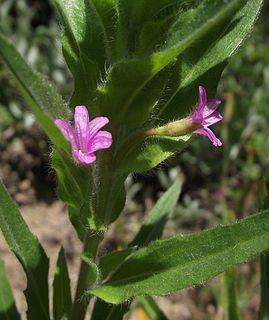
Epilobium densiflorum is a species of willowherb known by the common names denseflower willowherb, dense spike-primrose or dense boisduvalia. It is native to western North America from British Columbia to Baja California, where it is found in a variety of habitats. This is an erect annual often exceeding a meter in height with fuzzy green foliage. The pointed leaves are up to 8 centimeters long near the base of the plant, and the upper leaves are generally more hairy than the lower. The stem may branch or not. The top of the stem is occupied by a hairy, leafy, densely flowered inflorescence. Each flower has four deeply notched petals in shades of pinkish purple to nearly white with dark veining, each about a centimeter long. The fruit is a cylindrical capsule about a centimeter long.

Ipomopsis congesta is a species of flowering plant in the phlox family, known by the common name ballhead ipomopsis. It is native to much of western North America, where it grows in many habitats from alpine peaks to low-elevation scrub. It is a perennial herb which varies in appearance, especially across subspecies and climates. It may take the form of a squat patch with stems under 10 centimeters in height or a more erect form up to 30 centimeters tall. The stems are often hairy to woolly. The thick leaves are usually fork-shaped with a number of clawlike lobes and 1 to 4 centimeters long. The flowers appear in a rounded, dense cluster atop the stem. Each flower is bell-shaped to funnel-shaped and white with a pale yellow throat and protruding yellow or white stamens. There are several subspecies, many of which were formerly considered species of Gilia.
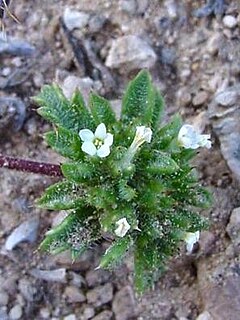
Ipomopsis polycladon is a species of flowering plant in the phlox family known by the common name manybranched ipomopsis. It is native to much of the western United States and northern Mexico, where it grows in sandy soils such as those of the deserts. This is an annual herb producing a number of horizontal red stems extending outward from the short central stem. Leaves appear at the ends and axils of branches. Each leaf is multilobed, and mostly green but often red-tipped, and less than 2 centimeters long. Stems and leaves are covered with woolly glandular hairs. The long stem branches bear inflorescences of leaflike bracts which are green with sharp-pointed red tips, and tiny white flowers a few millimeters across.

Ipomopsis tenuifolia is a species of flowering plant in the phlox family known by the common name slenderleaf skyrocket, or slenderleaf ipomopsis. It is native to Baja California with its range extending just into California and Arizona, where it is a plant of the deserts and chaparral. This is a perennial herb taking the form of a neat clump of slender, erect multibranched stems reaching a maximum height near 40 centimeters. The leaves are narrow to threadlike and occur all along the stem branches. The inflorescences appear at or near the tips of the branches and each holds one to seven bright scarlet flowers. Each flower is a tube 1 to 2 centimeters long opening into a flat or bell-shaped corolla with squared or toothed lobes. The five stamens and one style protrude far out of the mouth of the flower. The stamens have white to purple anthers and the style has three whitish stigmas.
Ipomopsis tenuituba is a species of flowering plant in the phlox family known by the common name slendertube skyrocket, or slendertube ipomopsis. It is native to much of the western United States from California to Colorado, where it is found on rocky mountain slopes. This is a perennial herb producing an erect stem with widely spaced leaves, each 3 to 6 centimeters long and with many narrow, fingerlike lobes. The inflorescences toward the top of the stem each hold three to seven flowers. The flower is very pale to medium pink, sometimes with white streaks, or solid white. It is a tube 2 to 5 centimeters long, opening into a corolla of five twisting, pointed, ribbonlike lobes. The stamens and style do not protrude far from the mouth of the flower, if at all. While it is a perennial plant, it dies after its first flowering.

Allium tuolumnense is a rare species of wild onion, known by the common name Rawhide Hill onion.

Androsace occidentalis is a species of flowering plant in the primrose family known by the common name western rockjasmine.

Campanula shetleri is a rare species of bellflower known by the common name Castle Crags bellflower. The plant is named for Castle Crags, a mountain formation in its limited native range, within the Shasta-Trinity National Forest.
Chaenactis alpigena is a species of flowering plant in the daisy family known by the common name southern Sierra pincushion. It is native to the High Sierra Nevada and the White Mountains of California, extending in the latter just into Nevada.
Podistera nevadensis is an uncommon species of flowering plant in the carrot family known by the common names Sierra podistera and Nevada podistera.
Romanzoffia tracyi is a species of flowering plant in the borage family known by the common names Tracy's mistmaiden and Tracy's romanzoffia. It is native to the coastline of western North America from far northern California north to the southern tip of Vancouver Island, where it grows among rocks on oceanside bluffs.

Stellaria calycantha is a species of flowering plant in the family Caryophyllaceae known by the common name northern starwort. It is native to western North America from Alaska and northwestern Canada to California and New Mexico, as well as eastern Russia. It occurs in subalpine and alpine climates, in many types of moist, shady habitat. It is a rhizomatous perennial herb producing a prostrate to erect stem up to 25 centimeters long, taking a clumpy form. The thin oval leaves have smooth edges and pointed tips, and measure up to 2.5 centimeters in length. The inflorescence bears one or more flowers, each on a long pedicel. Each flower has five pointed green sepals, and some flowers have up to five deeply lobed white petals.
Stellaria umbellata is a species of flowering plant in the family Caryophyllaceae known by the common names umbrella starwort and umbellate starwort. It is native to western North America from Alaska and northwestern Canada to the southwestern United States, as well as parts of Asia, including Siberia. It grows in subalpine and alpine climates in mountain forests and riverbanks. It is a rhizomatous perennial herb producing a slender prostrate stem up to about 20 centimeters long, sometimes forming clumps or mats. The stem is lined with pairs of oval leaves each up to about 2 centimeters long. The inflorescence is an umbel-shaped array of several flowers each on an arching or erect pedicels. The flower has five pointed green sepals each no more than 3 millimeters long. There are occasionally tiny white petals within the calyx of sepals, but these are generally absent.
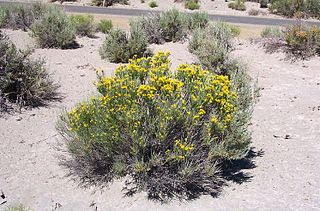
Tetradymia glabrata is a species of flowering plant in the aster family known by the common name littleleaf horsebrush. It is native to the western United States, especially the Great Basin and Mojave Desert. Its habitat includes sagebrush, woodlands, and scrub. It is an erect, bushy shrub growing to a maximum height over one meter, its stems coated unevenly in white woolly fibers with many bare strips. The narrow, pointed leaves are usually no more than a centimeter long and most occur in clusters along the branches. The inflorescence bears up to seven flower heads which are each enveloped in four woolly phyllaries. Each head contains four yellow cream flowers each around a centimeter long. The fruit is a hairy, ribbed achene with a pappus of bristles.
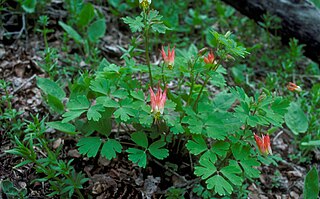
Aquilegia elegantula is a species of columbine known by the common name western red columbine. It is native to the southwestern United States, particularly the Four Corners states, and northern Mexico, where it grows in moist areas in mountain coniferous forests. It is a rhizomatous perennial herb growing 10 t 60 centimeters tall. The green leaf blades are borne on long, slender petioles and divided into three leaflets which each have rounded lobes along the front edges. The flower has five long petals up to 3 centimeters in length including their elongated, knob-tipped spurs. The petals are bright red in the spurs and lighten to yellow-green or orange at the tips. Between the petals are the oval-shaped sepals, which are reddish to yellowish in color and are held parallel to the petals. Flowers often droop such that the mouth is toward the ground and the spurs point up; the flowers are pollinated by the broad-tailed hummingbird.
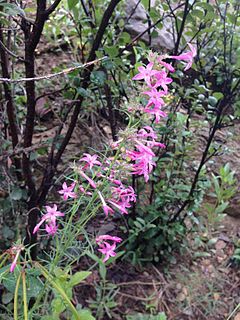
Ipomopsis sancti-spiritus is a rare species of flowering plant in the phlox family known by the common name Holy Ghost ipomopsis. It is endemic to New Mexico in the United States, where it is known from only one canyon in the Sangre de Cristo Mountains. It is a federally listed endangered species.
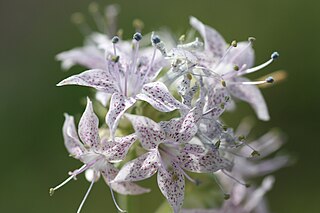
Ipomopsis polyantha is a rare species of flowering plant in the phlox family known by the common names Pagosa ipomopsis, Pagosa skyrocket and Archuleta County standing-cypress. It is endemic to Colorado in the United States, where it occurs only in the vicinity of Pagosa Springs in Archuleta County. It is threatened by the loss of its habitat to residential and commercial development. It was federally listed as an endangered species in 2011.
Cymopterus goodrichii is a rare species of flowering plant in the carrot family known by the common name Toiyabe springparsley. It is endemic to Nevada in the United States, where it occurs in the Toiyabe and West Humboldt Ranges.
Ipomopsis globularis is a species of flowering plant in the phlox family known by the common name Hoosier Pass ipomopsis. It is endemic to Colorado in the United States, where it grows in the Rocky Mountains.












